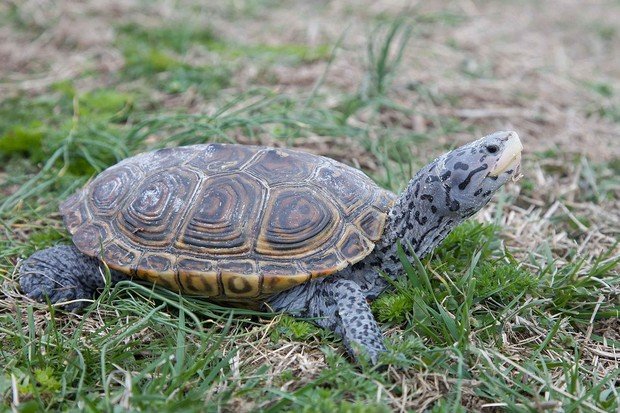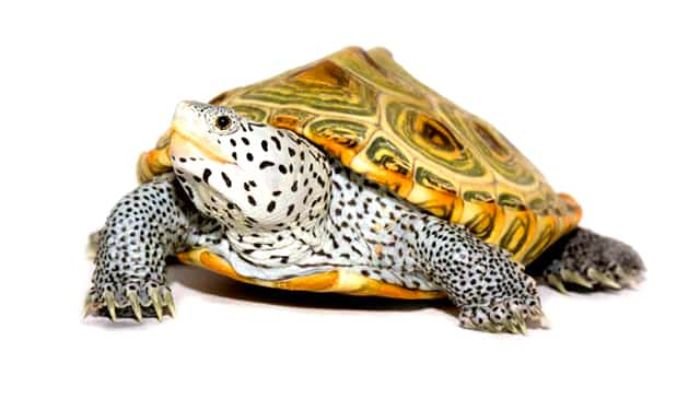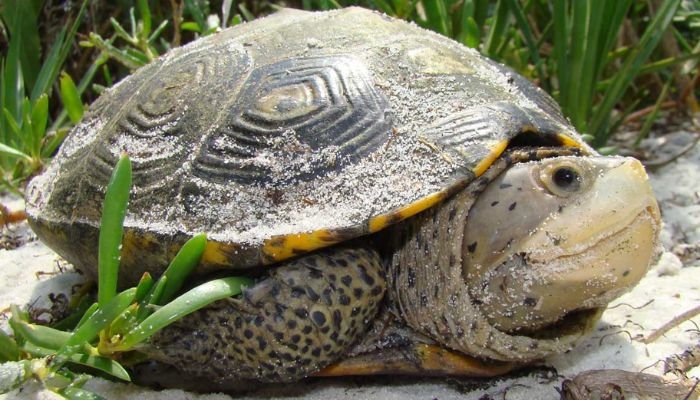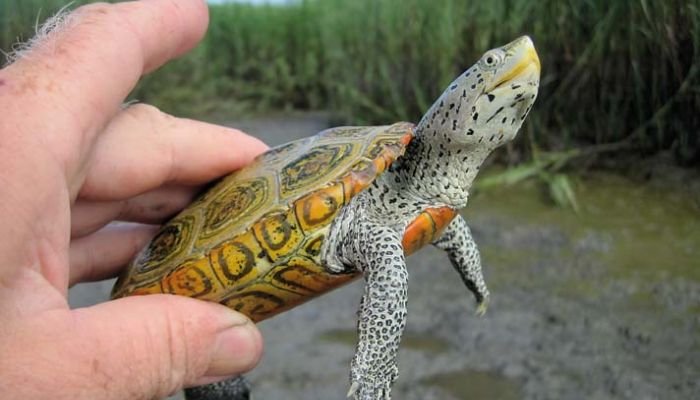
The Diamondback Terrapin is a striking species of turtle that inhabits the coasts of North America. It is a turtle that inhabits salt marshes, estuaries, and tidal streams. It is characterized by its exquisite shell pattern and diamond-shaped scutes. The omnivorous diamondback terrapin consumes numerous aquatic vegetation, crustaceans, and small fish.. Here are Diamondback Terrapin Guide on Food, Habitat, Size, Lifespan & Predators below-
Diamondback Terrapin Stats in Table format
The stats are given below for Diamondback Terrapin
| Reptiles List | Diamondback terrapin |
|---|---|
| Family | Emydidae |
| Type | Turtle |
| Size | Medium |
| Length | Diamondback terrapin: Up to 5-10 inches (13-25 cm) |
| Color | Diamondback terrapin: The color varies depending on the subspecies, but diamondback terrapins can have shades of black, brown, or gray with lighter or darker patterns. |
| Weight | Diamondback terrapin: Can weigh between 0.5 to 2 pounds.. |
| Lifespan | 20-40 years (or more) |
| Reproduction | Oviparous, lays eggs |
| Gestation Periods | The gestation period for a diamondback terrapin is approximately 60-75 days. |
| Endangered Status | Near Threatened (IUCN Red List) |
| Features | Diamond-shaped patterns, webbed feet |
| Country & Areas | United States, specifically along the Atlantic and Gulf coasts from Massachusetts to Texas. |
Diamondback Terrapin Natural Habitat and Distribution
The Atlantic and Gulf coasts are the most common habitats for diamondback terrapins in the United States. Saltwater lagoons, estuaries, tidal creeks, and coastal salt marshes are their natural habitats. These regions provide both freshwater and saltwater, just what the terrapins need to survive.
Diamondback Terrapin Physical Features and Adaptations
Here are some information about Diamondback Terrapin:-
Body Structure
The body of a diamondback terrapin is big and flattened because it has evolved to a marine environment. Their legs are well-adapted for both land and sea travel, and their webbed feet help them swim.
Coloration and Patterns
The lovely diamond pattern of yellow or tan lines against a dark backdrop that lends these creatures their name can be seen on the carapace (the top shell). Spots and stripes help these animals blend into their wetland environments by disguising their heads and limbs.
Defense Mechanisms
Diamondback terrapins have many defense mechanisms to fend off predators. To begin with, they are able to smash and consume shellfish thanks to their powerful jaws and keen beaks. Second, they have the ability to pull their head and limbs into their shell when they feel threatened.
Diamondback Terrapin Diet and Feeding Habits
Here are some information about Diamondback Terrapin:-
Diet Type
The diet of a diamondback terrapin includes both plant and animal materials.

Preferred Food Sources
Crabs, mollusks, shrimp, tiny fish, and aquatic insects make up the bulk of their diet. They’ll also eat anything like algae and trash that turns up in the water.
Feeding Schedule
Diurnal animals, like terrapins, are the most active during daylight hours. Low tide, when more prey is exposed, is a prime time for them to go on their foraging sprees.
Diamondback Terrapin Housing and Enclosure Requirements
Here are some information about Diamondback Terrapin:-
Terrarium Size and Setup
If you’re planning on keeping diamondback terrapins as pets, you’ll need to make sure they have plenty of room to roam. Because of their intermediate aquatic lifestyle, the enclosure must feature both water and land. For one adult terrapin, the minimum recommended tank size is 40 gallons, although the more space the better.
Substrate Options
A substrate that is representative of their native environment is ideal for the terrarium. An appropriate substrate that facilitates digging and nesting can be created by combining sand and fine gravel.
Temperature and Lighting
Maintaining a temperature gradient in the enclosure is essential for terrapins, thus they need a basking area with a heat lamp. The ideal temperature for the basking area is 85°F (29°C), while the surrounding area can be maintained at 75°F (24°C). Their calcium metabolism and general health are greatly aided by UVB illumination.
Humidity and Water Needs
Terrapins require constant moisture in the air. A swimming pool of a few inches’ depth or more should be included in the terrarium. The water should be slightly salty to mimic the conditions they’d find in the wild. A steady supply of clean water is required for both drinking and bathing.
Diamondback Terrapin Behaviour and Temperament:
Here are some information about Diamondback Terrapin:-
Activity Levels:
Daytime is when you’re most likely to see a diamondback terrapin moving around. They spend much of their time in the water, where they may swim and forage for food as semi-aquatic organisms. They can quickly swim and maneuver around their wet environments. They may lie in the sun in grassy or sandy regions to cool off when they’re on land.
Social Behaviour:
While terrapins tend to be solitary creatures, it is not uncommon to spot multiple individuals in close proximity to one another during the mating season. They don’t have elaborate social structures, but they may have brief encounters while vying for limited resources like basking sites or food.

Handling and Taming:
Minimizing the amount of time spent with terrapins can help keep the animals happy and healthy. They are not pets and may react negatively to excessive handling because of this. The ideal way to study terrapins is from a safe distance within their enclosure, where they may act naturally and without stress.
Diamondback Terrapin Breeding and Reproduction:
Here are some information about Diamondback Terrapin:-
Mating and Courtship Rituals:
Male terrapins are more active and may engage in wooing rituals to attract females during the spring mating season. It’s possible that they’ll swim about the ladies and give them a gentle prod with their noses or fins. As men fight for the attention of women, we also see an increase in hostility between them.
Incubation and Hatchlings
Following a successful mating, the female terrapin will look for a safe place to deposit her eggs. She like to nest in sandy soil, and does so frequently near the shoreline. She lays her eggs, then covers them up and swims back to the sea. After around three months of incubation time, the hatchlings emerge from their eggs. Baby terrapins have an innate need to be near water once they hatch.
Diamondback Terrapin Common Health Issues and Veterinary Care
Here are some information about Diamondback Terrapin:-
Respiratory Infections
Inadequate husbandry, such as not providing enough heat or humidity, can cause respiratory illnesses in terrapins. Some of the symptoms include wheezing, runny nose, and fatigue. Any indication of breathing problems requires prompt veterinary intervention.
Parasites
Terrapins are susceptible to parasites like worms and ticks. Parasite infestations can only be diagnosed and treated with regular fecal examinations. Parasites can be avoided with regular cage cleaning and a healthy diet.
Metabolic Bone Disease
Terrapins, like many reptiles, suffer from metabolic bone disease due to insufficient calcium and vitamin D3 in their diet. This can cause brittle bones, abnormal shell development, and other problems. The prevention of this condition depends on providing a healthy diet and adequate UVB lighting.

Importance of Regular Vet Check-ups
Diamondback terrapins, especially those housed in captivity, require routine veterinary care. A vet with experience with reptiles will be able to provide in-depth health evaluations, nutritional guidance, parasite screenings, and treatment options. The terrapins’ longevity and quality of life can be greatly enhanced with early diagnosis and treatment of health problems.
Conclusion:
The fascinating diamondback terrapin is well-suited to its coastal home thanks to a number of interesting adaptations. Active and nimble in the water, these swimmers are essential to the health of their respective habitats. If you’re thinking about getting a terrapin as a pet, make sure you give it a warm, dry place to live and feed it a healthy food. They can have healthy, happy lives with minimal stress if their natural tendencies are respected and they are handled as little as possible. In order to ensure the long-term care and conservation of this amazing species, regular veterinarian check-ups are essential for monitoring their health and addressing any potential difficulties swiftly.
FAQs
Q: What is the average size of a Diamondback terrapin?
Emydidae is a family that includes Diamondback terrapins. The Diamondback terrapin is a well-known turtle species.
Q: How long can a Diamondback terrapin grow in size in length?
Adult Diamondback terrapins typically range in size from around 5-10 inches (13-25 cm) in length.
Q: What colors do Diamondback terrapin come in?
The maximum length for an adult diamondback terrapin is 25 centimeters (approximately 10 inches).
Q: How big can a Diamondback terrapin get in weight?
The coloration of A. diamondback terrapins varies from subspecies to subspecies. These magnificent creatures are sometimes found with bright or dark markings and can appear black, brown, or gray.
Q: What are the special Features of a Diamondback terrapin?
The fascinating diamondback terrapin’s weight range is 0.5–2.0 pounds.
Q: What are the special Features of a Diamondback terrapin?
The Diamondback Terrapin is distinguished by its A. webbed feet and B. diamond-shaped markings.
Q: How long do Diamondback terrapin live?
Adult Diamondback terrapins have a remarkable life expectancy of 20-40 years, and may survive much longer under specific conditions.
Q: What food does the Diamondback terrapin eat?
Diamondback terrapins eat primarily small fish, crabs, mollusks, and insects. As opportunistic eaters, they have been known to feast on algae and other aquatic plants. They may have different food preferences depending on where they live and what kind of prey is easily accessible. Animals in captivity require a diet high in protein and calcium-rich meals to keep their shells healthy and strong.
Q: What is the best habitat for a Diamondback terrapin?
Diamondback terrapins prefer the brackish water found in areas such as salt marshes, estuaries, and tidal streams. Since they can live on both land and in water, these turtles are classified as semi-aquatic. Because of their ability to adapt to brackish conditions, diamondback terrapins thrive in ecosystems that combine salt and fresh water. They can only forage and nest in areas of shallow water with sandy or muddy bottoms. When it comes to the actual piece of land itself, they need sandy or muddy areas in which to sunbathe and build their nests. Vegetation, such as marsh grasses and shrubs, also offers shelter and concealment. To prevent the extinction of Diamondback terrapins, it is essential that we maintain clean water and leave their habitat alone.
Q: How do Diamondback terrapin give birth?
The diamondback terrapin lays eggs and is hence an Oviparous species.
Q: How long is the gestation period for a Diamondback terrapin?
Fecundation in diamondback terrapins occurs after a gestation period of about 60–75 days.
Q: What is the natural behavior of a Diamondback terrapin?
The Diamondback terrapin, of which there are many different kinds, spends most of its time in the ocean. They inhabit the brackish water of estuaries, salt marshes, and tidal streams throughout the eastern coast of North America. They are so proficient swimmers that they rarely leave the water. They are able to move on land and frequently do so to sun themselves in sandy or muddy areas. The Diamondback terrapin is well-known for its adaptability due to its ability to thrive in both saltwater and freshwater environments. They only socialize during mating season, and even then they would rather be left alone. Their whole temperament depends on being near water and being able to adjust to various coastal environments.
Q: Is the Diamondback terrapin endangered?
The status of the Diamondback terrapin is critical, as stated on the IUCN Red List.
Q: What are the prey of Diamondback terrapin?
Insects, small fish, crabs, mollusks, and amphibians are all part of the diamondback terrapin’s diet. They feed on a variety of plant species, including algae and seagrass.
Q: Do Diamondback terrapin have any Predators?
In reference to your inquiry, I can tell you that diamondback terrapins, Raccoons, foxes, skunks, crows, gulls, and even larger fish are among the many creatures and birds that hunt on diamondback terrapins. Because of their helplessness, diamondback terrapin eggs and hatchlings are easy prey for these predators. Alligators and snapping turtles are two of the many predators that prey on adult terrapins. The diamondback terrapin has evolved several special defenses to fend off these dangers, including a hard shell and the ability to conceal its eggs in sandy soil.
Q: How Fast Does Diamondback terrapin Move?
On land, the Diamondback terrapin can reach speeds of up to 3 miles per hour, and in the water, it may reach speeds of up to 2 miles per hour.
Q. What is Bite Force of Diamondback terrapin in PSI?
The PSI value for a diamondback terrapin’s bite is kept undefined due to the animal’s high degree of variation and the paucity of study on the subject.
Q: Can we keep Diamondback terrapin as pets?
Diamondback terrapins are excellent pets, thus the answer is yes. They’re cute small turtles that do well as pets as long as they’re kept in a tank or enclosure. However, they require extra care and a nutritious food in order to thrive. Be well-versed in the needs of such an animal before bringing one into your home as a pet.
I hope you like reading on Diamondback Terrapin FAQ Guide on Food, Habitat, Size, Lifespan and Predators.
